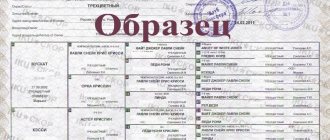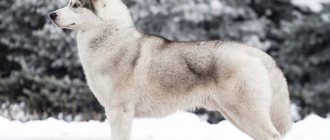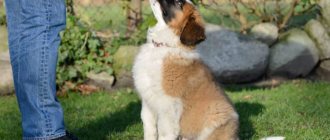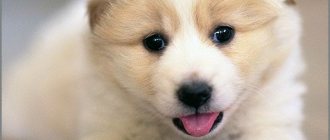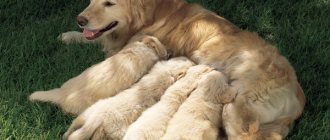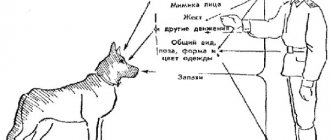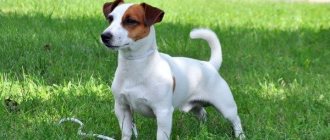How to prepare a dog for a show?
You need to think about how and why to prepare your pet for an exhibition from an early puppy age.
An exhibition is a kind of competition with its own strict rules, which means your pet will be judged on certain qualities. The first is appearance. Not only the exterior and compliance with standards are important here, but also the neatness of the animal. The second is presentation. The animal must demonstrate the ability to behave in public. It is these two parameters that you will have to work on from the very moment the puppy arrives at your home. You need to find out the appearance standards for your dog’s breed, learn how to maintain your pet’s neat appearance on your own, and, if necessary, find a professional groomer. It is important to remember that the appearance of the future champion very much depends on the diet. High-quality, balanced nutrition from the first months of life is something that deserves special attention. You should also additionally focus on the condition of the coat and skin. There are special complete animal feeds that improve coat quality, for example, the Purina® Pro Plan® line with OptiDerma® complex.
Education and psychological training occupy a separate place in preparation. From a very early age, it is necessary to begin to accustom the puppy to the basic commands: “come to me”, “near”, “sit”, “stand”, “lie down”, “fu”, etc. The best way to teach your baby commands is to turn learning into a game. This way the dog will happily complete the assigned tasks without expecting additional incentives. It is under no circumstances recommended to punish your pet during training. As soon as the quarantine ends after vaccinations, it is necessary to begin socialization of the animal. Spend as much time in the fresh air as possible, communicate with other dogs, go out into crowded places, travel on public transport - all this will greatly help the animal not to get lost and remain calm in the crowd.
In order to finally train your dog before the ring, it is best to contact a professional. A handler is a person who will teach your dog to move around the ring correctly, stand in a stance, select the necessary accessories, and hone the nuances of training. As a rule, handlers specialize in one or two breeds of dogs and know very well all the features of their exhibitions.
Exhibition classes
All ages of dogs taking part in the exhibition are usually grouped into classes:
- Baby (from 4 to 6 months).
- Puppies (from 6 to 9 months).
- Juniors (from 9 to 18 months).
- Intermediate (from 15 to 24 months).
- Open (from 15 months).
- Worker (from 15 months for dogs with appropriate diplomas).
- Champions (from 15 months for participants who have a certificate of Champion of an FCI member country or InterChampion).
- Veterans (from 8 years old).
A lot of people and dogs gather at exhibitions
What kind of exhibitions are there?
There are single-breed and all-breed exhibitions. They, in turn, are divided into ranks. Thus, all-breeds can be international (CACIB rank) and national (CAC rank).
Russian exhibitions are divided into three ranks:
- champion of the national breed club (national exhibition, held once a year);
- club winner (interregional exhibition);
- candidate for club champion (regional exhibition);
Depending on age and status, dogs compete in different classes:
- “BABY” – animals aged from three to six months;
- “PUPPY” – puppies from six to nine months;
- “JUNIOR” – dogs aged from nine months to one and a half years;
- “INTERMEDIATE” – from 15 to 24 months;
- “WORKING” presupposes that the animal has a working diploma;
- “CHAMPION” (champions) – dogs with titles recognized by the FCI participate;
- “WINNER” (winners) – if there is a CCC certificate and a National Club Winner;
- veterans – for dogs over eight years old.
Exhibition ranks and exhibition classes
All certificates are assigned and titles are issued only to dogs that have RKF pedigrees or are recognized by the RKF. All the titles listed below are entered into the Verk RKF Verkhovna Rada and are printed in certificates of origin (extracts from the RKF Verkhovna RKF Verkhovna Rada), issued to the descendants of this dog.
I. TITLES REGISTERED BY A SET OF CERTIFICATES
All-breed titles:
CHAMPION OF RUSSIA (CR) / RUSSIAN CHAMPION (CH RUS)
To obtain the title “CHAMPION OF RUSSIA” you must:
• For dogs registered in the Verkhovna RKF RKF: 4 CAC received from 4 different judges at RKF shows of the rank CAC and / or CACIB; There must be at least a year between the first and last CAC.
A one-year interval between the first and last CAC certificate is not required if: – the dog has the title “Young Champion of Russia”;
– the dog has 4 CAC, obtained from 4 different judges only at shows of the CACIB rank;
– the dog has 6 CAC from 6 different judges.
Special conditions:
– for dogs that have a certificate “Winner of Eurasia” or “Winner of Russia”, the title “Champion of Russia” is issued by 1 CAC received from another judge at
• For dogs registered in the stud books of other FCI or AKC, KC, CKC countries: 1 CAC, obtained at any RKF show of CAC or CACIB rank, and a certificate / diploma of the champion of the country of residence, provided that this country issues titles to Russian champions one at a time CAC; 2 CACs obtained from two different judges at any RKF exhibitions of CAC or CACIB rank, and a certificate / diploma of the champion of the country of residence, if this country does not issue titles to Russian champions under one CAC (if issued under 2 CACs, there is a one-year interval between the first and second certificates not required). Dogs that do not have a champion diploma from their country of residence are awarded the title of Russian champion according to standard rules. R.CAC is counted as CAC if it is obtained for a dog that has a registered title of Russian champion. In addition, when claiming the Russian champion title, 2 R.CAC can be counted as 1 CAC (one time). For dogs that received their first CAC before 12/31/2018, at the request of the owners, titles can be issued under both the old and new rules. Dogs that received their first CAC after 01/01/2019 will receive titles only according to the new rules.
JUNIOR CHAMPION OF RUSSIA (JCH RUS) / RUSSIAN JUNIOR CHAMPION (JCH RUS)
To obtain the title “JUNG CHAMPION OF RUSSIA” you must:
• For dogs registered in the Verk RKF: 3 JCAC, obtained from 3 different judges at RKF shows of the CAC and / or CACIB rank. Special conditions: at international exhibitions “Russia”, “RKF President’s Cup”, “Eurasia”, “RKF Cup”, “A.P. Mazower Memorial”, JCAC counts as 2 JCAC, R.JCAC counts as JCAC.
• For dogs registered in the stud books of other countries FCI or AKC, KC, CKC: 1 JCAC, obtained at any RKF show of CAC or CACIB rank, and a certificate / diploma of the junior champion of the country of residence. Dogs that do not have a diploma of a junior champion of their country of residence are awarded the title of junior champion of Russia according to standard rules.
R.JCAC is counted as JCAC if it is obtained for a dog that has a formalized title of Russian Junior Champion. In addition, when claiming the title of Russian junior champion, 2 R.JCAC can be counted as 1 x JCAC (one time). Diplomas according to these rules are issued from 01/01/2019. JCAC certificates received before 12/31/2018 are taken into account.
VETERAN CHAMPION OF RUSSIA (VCHR) / RUSSIAN VETERAN CHAMPION (VCH RUS)
• For dogs registered in the Verkhovna RKF RKF: 3 VCAC, obtained from 3 different judges at RKF shows of the CAC and / or CACIB rank. Special conditions: at international exhibitions “Russia”, “RKF President’s Cup”, “Eurasia”, “RKF Cup”, “A.P. Mazower Memorial”, VCAC counts as 2 VCAC, R.VCAC counts as VCAC. • For dogs registered in the stud books of other countries FCI or AKC, KC, CKC: 1 JCAC, obtained at any RKF show of CAC or CACIB rank, and a certificate / diploma of a veteran champion of the country of residence. Dogs that do not have a veteran champion diploma in their country of residence are awarded the title of Russian veteran champion according to standard rules. R.VCAC is counted as VCAC if it is obtained for a dog that has a registered title of Russian Veteran Champion. In addition, when obtaining the title of Russian veteran champion, 2 R.VCAC can be counted as 1 VCAC (one time). Diplomas according to these rules are issued from 01/01/2019. For the period from 06/05/2018 to 12/31/2018, in addition to VCAC certificates, “excellent 1, CW” diplomas received in the veteran class are taken into account.
CHAMPION RKF (ChRKF) / RKF CHAMPION (CH RKF)
To obtain the title “CHAMPION of the RKF” you must:
• Option 1. 1 certificate from ChRKF.
• Option 2. 3 “CHAMPION OF THE FEDERATION” (BSF) certificates from 3 different federations; certificates must be obtained under a minimum of two different judges.
RKF JUNIOR CHAMPION (JCH RKF)
To obtain the title “JUNG CHAMPION OF RKF” you must:
• Option 1. 1 certificate of the YuChRKF;
• Option 2. 2 certificates “JUNG CHAMPION OF THE FEDERATION” (YUCF) of 2 different federations; certificates must be obtained under different judges.
VETERAN-CHAMPION RKF (VCHRKF) / RKF VETERAN CHAMPION (VCH RKF)
To obtain the title “VETERAN-CHAMPION OF RKF” you must:
• Option 1. 1 VChRKF certificate;
• Option 2. 2 certificates “VETERAN-CHAMPION OF THE FEDERATION” (VCF) of 2 different federations; certificates must be obtained under different judges.
PRODUCER CHAMPION (PRCH RUS)
To obtain the title “CHAMPION MANUFACTURER” you must:
• For females: 4 champion offspring obtained from at least two different sires. • For males: 8 champion offspring obtained from at least two different studs. The titles of champions of FCI countries, as well as AKC, KC, CKC are taken into account. Diplomas according to these rules are issued from 01/01/2019.
Specialized titles for breeds with NCP:
CHAMPION NKP (CHNKP) / NATIONAL BREED CLUB CHAMPION (CH CLUB RUS)
To obtain the title “NCP Champion” you must:
• For dogs registered in the Verkhovna RKF: 4 CCs received from 4 different judges. 2 out of 4 certificates must be obtained only at special breed shows of the RKF National Club; 2 more certificates can be obtained both at single-breed exhibitions and in specialized breed rings (specialty) at RKF exhibitions of CACIB rank for dogs of all breeds or CAC rank for certain groups of breeds. Special conditions:
– for dogs that have the certificate “Winner of the National Club Club [of the year]”, awarded at the annual national exhibition, the title “Champion of the National Club Club” is issued for 1 CC, received from another judge at any special breed show of the National Club Club RKF or in a specialized breed ring; – at the national NKP exhibition of the rank “Winner of the NKP [of the year]” the CCC certificate is counted as 2 CCC, CC is counted as CCC;
• For dogs registered in the stud books of other countries FCI or AKC, KC, CKC: 1 CC and a certificate / diploma of the champion of the NKP of the country of residence (provided that this NKP issues titles to the champions of the Russian NKP for one CAC club). When obtaining the title “NCP Champion”, 3 CCs are counted as 1 CC (one time). NB: in breeds with working tests according to the FCI nomenclature, the title of National Club Champion is issued only if there is an internal or international certificate for one of the specialized species. A list of specialized types of tests (tests) for each specific breed is established by the NCP and approved by the RKF.
JUNIOR NKP CHAMPION (JCH CLUB RUS)
To obtain the title “Young National Club Champion” you must:
• For dogs registered in the Verkhovna RKF: 3 JCCCs received from 3 different judges. 1 out of 3 certificates must be received at a special breed show of the RKF National Club; 2 more certificates can be obtained both at single-breed exhibitions and in specialized breed rings (specialty) at RKF exhibitions of the CACIB rank or CAC rank for certain groups of breeds. Special conditions: at the national NKP exhibition of the rank “Winner of the NKP [of the year]”, the JKCHK certificate is counted as 2 JKCC, the JSS is counted as JKCC. • For dogs registered in the stud books of other FCI countries or AKC, KC, CKC: 1 JCCC and a certificate / diploma of the Junior Champion of the country of residence (provided that this NKP issues titles to the Junior Champions of the Russian NKP in one JCAC club). When obtaining the title “Young National Club Champion”, 3 JCC are counted as 1 JCC (one time).
VETERAN-CHAMPION NKP (VCHNKP) / NATIONAL BREED CLUB VETERAN CHAMPION (VCH CLUB RUS)
To obtain the title “Veteran National Club Champion” you must:
• For dogs registered in the Verkhovna RKF: 3 VKCHK, received from 3 different judges. 1 out of 3 certificates must be received at a special breed show of the RKF National Club; 2 more certificates can be obtained both at single-breed exhibitions and in specialized breed rings (specialty) at RKF exhibitions of the CACIB rank or CAC rank for certain groups of breeds. Special conditions: at the national exhibition of the NKP rank “Winner of the NKP [year]”, the VKCHK certificate is counted as 2 VKCHK, the VSS is counted as VKCHK.
• For dogs registered in the stud books of other countries FCI or AKC, KC, CKC: 1 VKCHK and a certificate / diploma of the Veteran Champion of the National Club of the country of residence (provided that this Scientific Club issues titles to the Veteran Champions of the Russian National Club for one VCAC club). When obtaining the title “Veteran-Champion of the National Club,” 3 VSS are counted as 1 VKCHK (one-time). For dogs that received the first certificate of KCHK, JKCHK, VKCHK before 12/31/2019, at the request of the owners, the corresponding titles can be issued according to the old rules (in the NCP). For dogs that received their first certificate after 01/01/2020, titles are issued only according to the new rules (in the RKF).
Specialized titles for breeds that do not have NKP:
CHAMPION OF BREED (PE) / BREED CHAMPION (BCH RUS)
To obtain the title “Breed Champion” you need: 4 CCPs obtained from 4 different judges in specialized breed rings (specialty) at RKF CACIB rank or CAC rank exhibitions for certain breed groups or at a national specialized breed exhibition.
Special conditions:
– for dogs that have a “Breed Winner of [Year]” certificate awarded at a national breed exhibition, the title “Breed Champion” is issued based on 1 CPR received from another judge;
– at a national specialized breed exhibition of the rank “Winner of Breed [of the Year]”, the KChP certificate is counted as 2 KChP, CC is counted as KChP. When obtaining the title “Breed Champion”, 3 CCs are counted as 1 CCP (one time). NB: in breeds with working tests according to the FCI nomenclature, the title of Breed Champion is issued only if there is an internal or international certificate for one of the profile species. The list of specialized types of tests (tests) for each specific breed is established by the Presidium of the RKF.
JUNIOR CHAMPION OF BREED (JUCH) / BREED JUNIOR CHAMPION (BJCH RUS)
To obtain the title “Young Breed Champion” you must:
3 JKChP obtained from 3 different judges in specialized breed rings (specialty) at RKF shows of the CACIB rank or CAC rank for certain groups of breeds or at a national specialized breed show. Special conditions: at a national specialized breed exhibition of the rank “Winner of Breed [of the Year]”, the JKChP certificate is counted as 2 JKChP, CC is counted as JKChP. When obtaining the title “Young Champion of the Breed”, 3 JCC are counted as 1 JKChP (one time).
BREED VETERAN CHAMPION (BVCH RUS)
To obtain the title “Veteran Champion of the Breed” you need: 3 VKChP obtained from 3 different judges in specialized breed rings (specialty) at RKF exhibitions of the CACIB rank or CAC rank for certain groups of breeds or at a national specialized breed exhibition. Special conditions: at a national specialized breed show of the rank “Breed Winner [of the Year]”, the VChKP certificate is counted as 2 VKChP, CC is counted as VKChP. When obtaining the title “Veteran Breed Champion”, 3 VCC are counted as 1 VKChP (one time). Diplomas according to these rules are issued from 01/01/2019.
Cumulative titles for dogs of all breeds
GRAND CHAMPION OF RUSSIA (GCH RUS) / RUSSIAN GRAND CHAMPION (GCH RUS)
To obtain the title “GRAND CHAMPION OF RUSSIA” you must:
• For breeds that have NKP: diploma “CHAMPION OF RUSSIA” and diploma “CHAMPION NKP”. • For breeds that do not have a National Club Certificate: diploma “CHAMPION OF RUSSIA” and diploma “CHAMPION OF BREED”.
JUNIOR GRAND CHAMPION OF RUSSIA (YUGCHR) / RUSSIAN JUNIOR GRAND CHAMPION (JGCH RUS)
To obtain the title “JUNG GRAND CHAMPION OF RUSSIA” you must:
• For breeds with NKP: diploma “JUNCH CHAMPION OF RUSSIA” and diploma “JUNG CHAMPION NKP”. • For breeds that do not have a National Club Certificate: diploma “JUNCH CHAMPION OF RUSSIA” and diploma “JUNG CHAMPION OF BREED”.
VETERAN GRAND CHAMPION OF RUSSIA (VGCHR) / RUSSIAN VETERAN GRAND CHAMPION (VGCH RUS)
To obtain the title “VETERAN GRAND CHAMPION OF RUSSIA” you must:
• For breeds that have NKP: diploma “VETERAN-CHAMPION OF RUSSIA” and diploma “VETERAN-CHAMPION NKP”.
• For breeds that do not have a National Club Certificate: diploma “VETERAN-CHAMPION OF RUSSIA” and diploma “VETERAN CHAMPION OF THE BREED”.
ABSOLUTE CHAMPION OF RUSSIA (ACH RUS) / RUSSIAN ABSOLUTE CHAMPIOPN (ACH RUS)
To obtain the title “ABSOLUTE CHAMPION OF RUSSIA” you need: a diploma “GRAND CHAMPION OF RUSSIA” and a diploma “CHAMPION OF RUSSIA IN WORKING QUALITIES”. Diplomas according to these rules are issued from 01/01/2019. NB: All titles issued under a set of certificates are assigned to the dog once.
II. TITLES ISSUED BASED ON THE RESULTS OF INDIVIDUAL EXHIBITIONS
All-breed titles:
WINNER OF “EURASIAN” [indicating the year] (P “Eurasia”) / EURASIAN WINNER (EAW)
To obtain the title “Winner of Eurasia” you must have: a certificate “Winner of Eurasia” received at the exhibition “Eurasia”. This certificate is awarded to the best male and best female in the breed.
YOUNG WINNER OF "EURASIAN" [indicating the year] (UE "Eurasia") / EURASIAN JUNIOR WINNER (EAJW)
To obtain the title “Young Winner of Eurasia” you must have: a certificate of “Young Winner of Eurasia” received at the exhibition “Eurasia”. This certificate is awarded to the best junior male and the best junior female in the breed.
VETERAN-WINNER “EURASIAN” [indicating the year] (VP “Eurasia”) / EURASIAN VETERAN WINNER (EAVW)
To obtain the title “Veteran-winner of “Eurasia””, you must have: a certificate “Veteran-winner of “Eurasia””, received at the exhibition “Eurasia”. This certificate is awarded to the best veteran male and the best veteran female in the breed.
MOSCOW WINNER [indicating the year] (P Moscow) / MOSCOW WINNER (MW)
To obtain the title “Winner of Moscow” you must have: a “Moscow Winner” certificate received at the exhibition “Moscow Cup / Memorial A.P. Mazower." This certificate is awarded to the best male and best female in the breed.
JUNIOR WINNER OF MOSCOW [indicating the year] (UP of Moscow) / MOSCOW JUNIOR WINNER (MJW)
To obtain the title “Moscow Junior Winner” you must have: a “Moscow Junior Winner” certificate, received at the “Moscow Cup / Memorial A.P.” exhibition. Mazower." This certificate is awarded to the best junior male and the best junior female in the breed.
VETERAN-WINNER OF MOSCOW [indicating the year] (VP of Moscow) / MOSCOW VETERAN WINNER (MVW)
To obtain the title “Moscow Veteran Winner” you must have: a “Moscow Veteran Winner” certificate, received at the exhibition “Moscow Cup / Memorial A.P. Mazower." This certificate is awarded to the veteran male and the best veteran female in the breed. WINNER OF “RUSSIA” [indicating the year] (P “Russia”) / RUSSIAN WINNER (RW) To obtain the title “Winner of “Russia”” you must have: a certificate “Winner of “Russia”” received at the exhibition “Russia”. This certificate is awarded to the best male and best female in the breed.
YOUNG WINNER OF “RUSSIA” [indicating the year] (UP “Russia”) / RUSSIAN JUNIOR WINNER (RJW)
To obtain the title “Young Winner of Russia” you must have: a certificate of “Young Winner of Russia” received at the exhibition “Russia”. This certificate is awarded to the best junior male and the best junior female in the breed.
VETERAN-WINNER “RUSSIA” [indicating the year] (VP “Russia”) / RUSSIAN VETERAN WINNER (RVW)
To obtain the title “Veteran-winner of “Russia”” you must have: a certificate “Veteran-winner of “Russia””, received at the exhibition “Russia”. This certificate is awarded to the best veteran male and the best veteran female in the breed. Diplomas according to these rules are issued from 01/01/2019.
Specialized titles for breeds with NCP:
WINNER of the National Club [indicating the year] (P National Club) / NATIONAL BREED CLUB WINNER (CW RUS)
To obtain the title “Winner of the National Club Club” you must have: a diploma of “Best Male” or “Best Bitch” of the breed, received at the annual national exhibition of the National Club Club (rank “Winner of the National Club Club”).
JUNIOR WINNER OF THE NKP [indicating the year] (YUP NKP) / NATIONAL BREED CLUB JUNIOR WINNER (CJW RUS)
To obtain the title “Young National Club Winner” you must have: a diploma of “Best Junior Male” or “Best Junior Female” of the breed, received at the annual national National Club Show (rank “National Club Winner”).
VETERAN-WINNER of the National Club [indicating the year] (VP National Club) / NATIONAL BREED CLUB VETERAN WINNER (CVW RUS)
To obtain the title “Veteran-Winner of the National Club Club”, you must have: a diploma of “Best Male Veteran” or “Best Female Veteran” of the breed, received at the annual national exhibition of the National Club Club (rank “Winner of the National Club Club”). Diplomas according to these rules are issued from 01/01/2020. Specialized titles for breeds that do not have a national code: BREED WINNER [indicating the year] (PP) / BREED WINNER (BW RUS) To obtain the title “Breed Winner” you must have: a diploma “Best male” or “Best female” of the breed, received at annual national breed exhibition (rank “Breed Winner”).
JUNIOR WINNER OF BREED [indicating the year] (UPP) / BREED JUNIOR WINNER (BJW RUS)
To obtain the title “Young Breed Winner” you must have: a diploma of “Best Junior Male” or “Best Junior Female” of the breed, obtained at the annual national breed exhibition (rank “Winner of Breed”).
VETERAN-WINNER OF THE BREED [indicating the year] (WFP) / BREED VETERAN WINNER (BVW RUS)
To obtain the title "Veteran Winner of the Breed" you must have: a diploma of "Best Veteran Male" or "Best Veteran Bitch" of the breed, obtained at the annual national breed exhibition (rank "Winner of Breed"). Diplomas according to these rules are issued from 01/01/2020. All applications are submitted and titles are issued at the RKF office if reports from the relevant exhibitions are available. Certificates issued at shows of any rank count toward the title requirements for a period of 5 years.
Handlerspb.ru Handlerspb.rf
Copyright © Translation by Elena Fedorova
Conformation for Beginners: What Happens in the Ring
Step 1 : When it is time for the dogs to be shown in your class according to the show schedule, the ring manager will call the competitors into the ring according to their registration numbers listed in the show catalogue. Exhibitor numbers are attached to clothing in a visible place. As soon as the ring manager calls your number, you and your dog must proceed to the ring. As a rule, judges make a quick assessment of the dogs entering the ring. Participants enter the ring, line up on the right side of the ring entrance and place the dogs in show stands. It is advisable that there be at least 2 m between dogs. Dogs cannot be placed “head to head” - all dogs must look in the same direction.
Step 2 : After a brief inspection of the dogs, the judge will ask the competitors to start running the dogs around the ring. Running is done counterclockwise. The pace should be such that the dogs only trot around the ring.
If in the ring, according to your number, you are in first place in the line, then you must ask the other participants if they are ready before you start moving. If you are the first in the line, then you have one advantage - you can choose the running pace that suits your dog.
If you are not the first in the line, then while running you should not push from behind on the dog running in front. If you need to show your dog at a faster pace than the competitor running in front of you, then you must run in a larger circle. That is, those participants who want to show their dogs at a slower pace run along the inner diameter of the circle, and those who want to show their dogs at a faster pace run along the edge of the ring. This way, the judge will be able to see all the dogs at the same time, and the participants will not interfere with each other.
Step 3 : Competitors run around the ring with the dogs until the judge tells them to stop. Participants stop and line up to the left of the entrance to the ring. The dogs are placed back in the show racks. The judge begins a more thorough examination and palpation of the dogs. If your dog is a small breed, then the dogs are examined for convenience on a special table. The dog is placed on the table in a show position with its head in any direction.
If your number is number one, the judge will begin examining the dogs with your dog. He feels the dog’s body – shoulders, hips, limbs; examines the teeth and evaluates the correctness of the bite. In male dogs, judges check the testicles for the absence of cryptorchidism (the judge does this from the side of the tail, and not from the front - between the legs).
Step 4 : After thoroughly examining the dog, the judge may ask you to do one of the following standard dog show moves. When performing these standard movements, the judge evaluates the degree of parallelism in the movement of the dog’s limbs (clubfoot, sweeping, sideways, compensatory movements of the limbs, etc.).
The most common option is the Out and Back movement with the dog. You and your dog must move away from the judge, walk about 10 meters, turn around, walk back towards the judge and stop a few meters in front of him. The dog must trot.
Another movement option is the “Triangle”. The name of this movement speaks for itself. You and your dog should move away from the judge, walk about 10 m, turn left, walk another 5-7 m, then turn left again and return to the judge. The dog should trot constantly on your left side - this way it will always be in the judge’s field of view, i.e. you should not block it with your body.
The rarest option is the “L-movement” (L). Those. is a movement with a dog in the shape of the Latin letter “L”. You and your dog must move in the direction away from the judge, walk approximately 10 m, turn left, walk another 5-7 m. After this, you must take the ring in your right hand so that the dog is on your right, and return along the same route to to the judge. The dog must trot.
Step 5 : The judge will ask you to return to your place in the line while he continues to inspect the other dogs. It is advisable that even while examining other dogs, your dog should stand in a show position, since judges are constantly comparing dogs with each other. However, if there are a lot of participants, and the examination of other dogs is significantly delayed, then you should not torture the dog by constantly holding it in a standing position. Take breaks to let her relax. Otherwise, your dog will be so fatigued by the stance that upon final examination he will look tired and unnatural.
Step 6 : After thoroughly checking the dogs, the judge can return to the line and compare the dogs again. Be prepared for this, i.e. your dog must be placed in a show rack.
Step 7: As a rule, finally, before determining the winners, the judge invites the participants to run around the ring again.
Step 8 : After the judge asks the competitors to stop, he will announce the best dogs.
Source
Save and share:
Category: All about exhibitions | RSS |
Training
All dogs in the ring move at a special pace - trot; on command the pet must stop and stand in a certain stance. It is important that the dog does not interfere with the dental examination. It is possible to achieve easy performance of all tricks and clear exhibition behavior only through training.
Many owners are interested in how to prepare a dog for a show on their own and whether it is possible. If you have no or insufficient experience in raising animals, you won’t be able to do it on your own.
If you have serious plans for a dog, it is better to seek help from a professional handler - a person who shows dogs at shows.
Subscribe to the newsletter and receive a discount at the pet store “Lubimchik”
Thank you for subscribing!
This is the most reliable way; The specialist’s main task is to train the pet, but he will definitely give the owner detailed recommendations on training. However, very often it is the handler who brings the dog into the ring. As a professional, he can weigh the strengths and weaknesses of a dog and show it from its best side in front of the judges.

